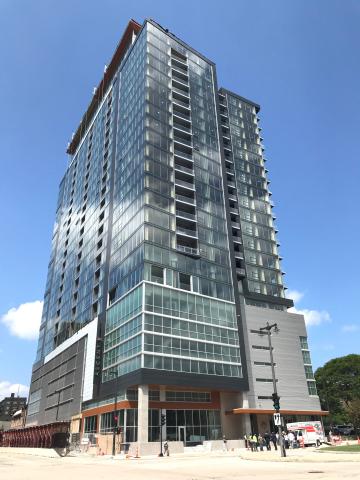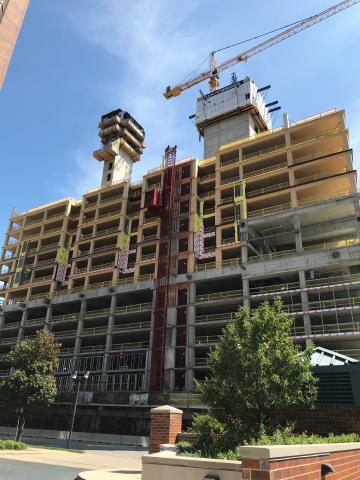World's tallest timber building opens
WISCONSIN—At 25 stories high—284 feet—the Ascent MKE Building, located in Milwaukee, Wisconsin, is officially the tallest mass timber building in the world, moving ahead of Norway’s Mjösa 18-story tower. The USDA Forest Service provided support for Ascent through the agency’s Wood Innovations program and Forest Products Laboratory fire testing. A wood innovations grant helped with engineering and design work, and the lab conducted critical fire testing of glued-laminated timber columns (glulam). Glulam is a manufactured wood product composed of layers of lumber glued together.
The burn test proved that oversized, yet unprotected, glulam columns do not lose structural integrity since outer layer charring protects internal layers. In fact, the lab’s glulam columns performed so well, they qualified for a three-hour fire resistance rating. Testing like this supports future code changes. The success of FPL’s three-hour burn test has opened the doors to new US mass timber building horizons.
“Who would have imagined…the tallest timber building in the world is in Milwaukee, Wisconsin,” said Brian Brashaw, who’s leading the Forest Service’s national mass timber market development efforts. “It’s real, it’s catalytic, and future mass timber projects like Ascent will support forest health and low carbon buildings across the country.”
Mass timber is a priority for the Forest Service, which is championing and investing in the United States’ emerging industry. Mass timber uses small and medium-sized trees to create beams, columns and building components. Removal of these trees from over-populated forests supports healthy forest management and reduces wildfire risk. It also creates new markets for wood products and promotes a more sustainable future.
“The Ascent project accelerates the opportunity for tall timber buildings in the U.S. Rooted in strong science, engineering and design—the project creates a vision for using wood as a natural carbon solution,” he said.
Wood buildings store tremendous amounts of carbon and reduce the fossil energy needed for construction over alternatives like concrete, steel and aluminum. They are also proving to be increasingly popular with builders due to the ease, speed and relative quiet of construction compared to steel and concrete high-rise construction.
Forest Products Lab scientists are also working with the Ascent team to support life cycle assessments, important tools that allow designers to do direct comparisons on the environmental footprint of wood buildings versus concrete. Life cycle assessments quantify the environmental impact of all phases of a building's life cycle, which allows designers, builders and consumers to understand a product’s long-term impact on the planet.
The Ascent MKE Building is the feature of a new episode of Engineering the Future. The timber skyscraper episode highlights the many layers of work needed to accomplish final construction of the Ascent building and features the Forest Service’s involvement in the project.



